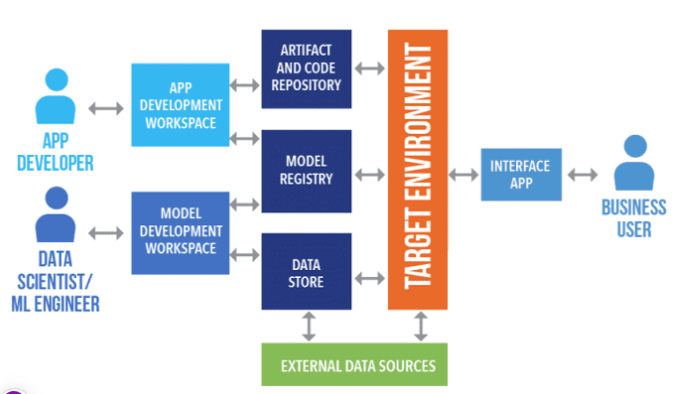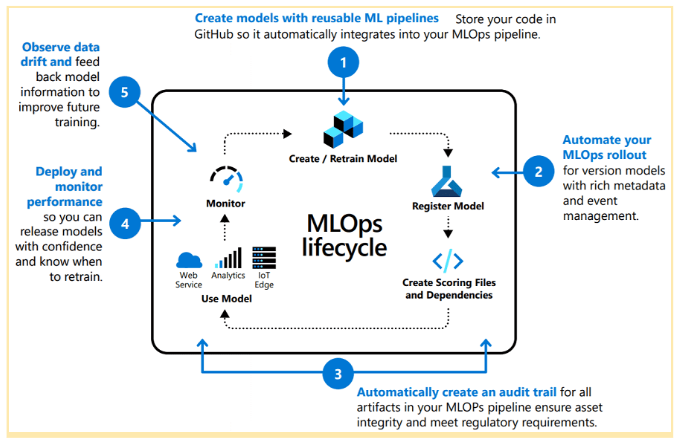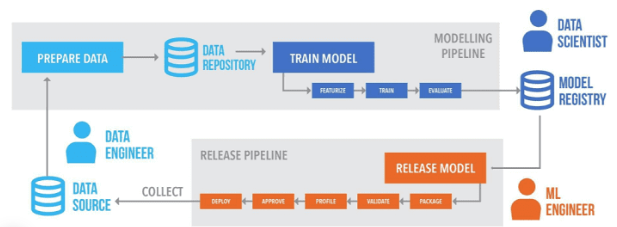What is MLOps? Why do businesses need it? Will you require specialists to support it? We answer those questions and more while exploring the background of MLOps and its applications.
MLOps is a relatively new concept. In just the past few years, we see the first mentions of the need for comprehensive management of the lifecycle of machine learning in industrial operations and production. In practice, the problem of implementing machine learning (ML) models in a real business is not limited to data preparation, development, and training of a neural network or other machine learning algorithms. Many factors influence the quality of a production solution, from dataset verification to testing and deployment in a production environment as a reliable Big Data application.
This means that the actual results of prediction or classification depend not only on the neural network architecture and the machine learning method that the data scientist proposed, but also on how the development team implemented this model, and administrators deployed it in a cluster environment. Also important is the quality of the input data (data quality), sources, channels, and the frequency of their receipt, which is the responsibility of the data engineer.
Organizational and technical obstacles in the interaction of diversified specialists involved in the development, testing, deployment, and support of ML solutions leads to an increase in the time for creating a product and a decrease in its value for a business. MLOps was invented to eliminate such barriers. Like DevOps and DataOps, MLOps seeks to increase automation and improve the quality of industrial machine learning solutions, paying attention to regulatory requirements and business benefits.

The typical process for developing and operating software products with machine learning models
Thus, MLOps is a culture and a set of practices for the integrated and automated lifecycle management of machine learning systems, combining their development and support operations , including integration, testing, release, deployment, and infrastructure management.
MLOps extent the CRISP-DM methodology with the help of an Agile approach and technical tools for automated operations with data, machine learning models, code, and environment. These tools include, for example, Cloudera Data Science Workbench.
It is expected that the application of MLOps in practice will avoid common mistakes and problems faced by data scientists working in accordance with the classical phases of CRISP-DM.

Contents
Top 10 Benefits for Business and Data Science
Of all the benefits of implementing MLOps, the following advantages of Agile approaches are considered the most significant in relation to the specifics of the industrial deployment of Machine learning:
- Reducing the time for obtaining high-quality results due to reliable and efficient management of the lifecycle of machine learning;
- Reproducible workflows and models thanks to Continuous Development/Integration/Training (CD/CI/CT) methods and tools;
- Ease of deployment of high-precision ML models anywhere and anytime;
- System of integrated management and continuous monitoring of machine learning resources;
- Elimination of organizational barriers and integration of experience of diversified ML specialists.
Therefore, with the help of MLOps, the following aspects of ML operations can be optimized:
- Unify the release cycle of machine learning models and software products created on their basis;
- Automate testing of machine learning artifacts, such as data validation, testing of the ML model itself and its integration into a production solution;
- Implement flexible principles in machine learning projects;
- Support machine learning models and datasets for them in CI/CD/CT systems;
- Reduce technical debt for ML models.
It is noteworthy that the organizational techniques of MLOps should be independent of the language, framework, platform, and infrastructure. And from a technical point of view, the general architecture of the MLOps system will include platforms for collecting and aggregating Big Data, applications for analyzing and preparing data for ML modeling, tools for performing calculations and analytics, as well as tools for automated movement of machine learning models, data and software products created on their basis between various processes of their lifecycle.
This will partially or completely automate the work tasks of a data scientist, a data engineer, an ML specialist, an architect and developer of Big Data solutions, as well as a DevOps engineer using unified and efficient pipelines (pipelines).

How Specialists Can Get Into MLops Practices
To understand how data scientists work, you can look at the CRISP-DM methodology—the phases that roughly coincide to the DS project.
Next, you need to know, in general, how the modern infrastructure works: CI/CD, logging experiments, how to version datasets, and the environment—in general, understand what a modern Data DevOps engineer does.
It is important to have a good understanding of the development process, including the lifecycle of a Data science product, and the work of the teams involved in it: data engineering, system engineering, data science, and the applied part are different integration options. That is, you need to generally understand how everything works in different parts of the project.
Also read: Building and Improving Your Credit Score: A How-To Guide
How To Choose A Platform For MLops
Fortunately, there are great choices. There is open source, such as MLflow, and there are cloud solutions that help automate any part of the pipeline.
You can start with any platform, see what tasks it solves, and how it solves them. For simplicity, you can take the implementation from the cloud vendor – SageMaker, Vertex AI, or Azure ML. Cloud providers are considered more convenient, because all additional components can be added with a few lines of code, making it possible to build end-to-end MLOps within a single platform. They are functionally similar: one language (Python API), terms, and features.
The documentation of the selected ML platform is enough to immerse yourself in the context. And then you can look at specific alternatives: different feature stores, ML pipeline engines, and model registries. There are certifications from providers that summarize this experience into a course.
In general, when choosing an MLOps platform, companies should consider larger business initiatives and plan ahead for the most appropriate building design. Discussions with executive boards, industry experts, and platform users will provide a collective understanding of the challenges and opportunities so that businesses can maximize profitability, productivity, and growth.
More from us: All-New Kovol PD 3.1 Charger Boost Macbook Pro 16” to 100% In 70 Minutes
Conclusion
Any company using machine learning technology would do well to adopt the principles of MLOps. As mentioned above, MLOps and other tools like ModelOps can help you improve your company’s performance, ensuring that the machine learning solutions you use provide the desired value.






